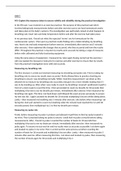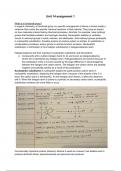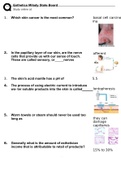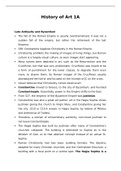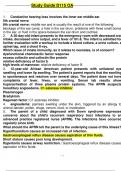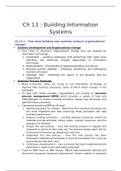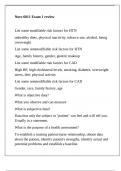LECTURE 1: HISTORY OF FOOD MARKETING
Marketing:
- Speech based communications: include traditional advertising (billboards, television, radio,
print ads) and broader promotional strategies (public relations communications and social
media content)
- Non-speech communications: establishing the price of products and determining where to
locate them within a store.
Food marketing: the act of communicating to the consumer through a range of marketing techniques
in order to add value to a food product and persuade the consumer to purchase.
This includes all activities that occur in between the completion of a product through to the
purchasing process of consumers.
Marketing mix (4P’s):
- Products: goods and services that the company will offer to the consumer. Creating a new
food product, modifying, or improving an existing food product.
- Price: pricing is important aspect to influence the buying activity when people are in stores or
to persuade people to go to the stores.
- Promotion: actions used to communicate a foods features and benefits, therefore
persuading the consumer to buy the product. Multiple avenues, such as out-of-store, in-
store, on packaging, food advertisements on television (to persuade to go to the store and
buy a product and promotions in magazines and newspapers (coupons)
- Place: distribution and warehousing efforts necessary to move a food from manufacturer to a
location where a consumer can buy it. It can also refer to where the product is located in a
retail outlets (end of an aisle, top, bottom, middle shelf, special display case, etc.)
Three (or four) phases distinguished:
Fragmentation phase (before – end of 19 th century):
- Country divided in numerous geographic fragments for food sales because transporting food
was expensive, leaving most production, distribution and selling locally based.
Unification phase (end of 19th century – mid 20th century):
- Distribution made possible by railroads, coordination of sales forces was made possible by
the telegraph and telephone, and product consistency by advances in manufacturing.
- New distribution was led by large food processors and companies such as Heinz, Quaker oats
and Coca Cola which sold their brands internationally.
- Prime marketing tools: print and direct marketing through demonstrations at stores and
public venues
Segmentation phase (1950 – current):
- Radio, television, internet advertising > more competing products to focus on different
benefits and images and thus appeal to different demographics and psychographic markets.
- More efficient distributions (flights, boats, trains, trucks) > sell brand and product worldwide
Personalized/tailored phase (2010 – current)
- Big data collections, artificial intelligence, machine learning, neuromarketing, eye tracking >
more personalized/tailored marketing possibilities.
,Objective food marketing: increase sales
The large food supply combined with a wealthy society in which people can afford to buy more food
than they need, sets the stage for competition. The food industry must compete for every dollar
spent on food, and food companies expend extraordinary resources to develop market products that
will sell, regardless of the effect on nutritional status or weights.
To satisfy the stakeholders > people need to eat more:
- Advertising
- Public relations
- Working tirelessly to convince government officials, nutrition professionals and the media
that their products promote health
Food marketing: <1% fruits and vegetables, 9% other, 40% fast-food, 51% sugar drinks etc.
Blue zones: people in blue zones eat for 95% plant-based food.
INTRODUCTION
Purposes to advertising:
- Provide information to potential purchasers about a product
- Induce positive feelings about a product
Consider restrictions to promotional marketing:
- Rights-based: people, primarily children should be protected from commercially driven
inducements to consumer (and over-consume).
- Risk based: market had freedoms that should only be curtailed on evidence of harm
LECTURE 2: MIX OF FOOD MARKETING
,Brands use attractive people and things to associate with their products (Red Bull uses Formula 1,
other cool sports, and Max Verstappen for advertising).
Link between the two trends:
- Increased expenditure food advertisements > energy dense snacks
- Increased obesity
Direct link: Food advertisements have a direct effect on:
- Brand/product attitudes: you like it
- Cognitions: you will think about product > more probability you will buy it
- Emotions: eat a snicker > it makes you happy
- Eating/consumption behaviour
Main question:
- Is there a causal relationship between food advertisement and food intake?
- Does food marketing have a role in the obesity epidemic?
Association between televisions viewing and obesity remains significant even when potential
confounding variables such as socioeconomic status, familial tendency to overweight and levels of
physical activity are considered.
Food marketing:
- Old media/advertisements: tv, newspaper, radio, magazines, billboards
- New media/advertisements: banners on website, social media, product placements in
movies, shows, series
- Promotional characters
- Celebrity endorsements
- Viral marketing
- Program and event sponsorship (McDonalds tennis tournament)
- Advertising within schools
- Trend in increased embedding food cues in content
Advergames:
- Computer games specifically creates to function as advertisements to promote brands,
where the entertainment content mimics traditional game forms
- Designed in particular for children
Why target children:
- Tailored marketing is the new device
- Children are easy to manipulate
o Nag-factor: constantly asking for advertised items
o Can and do spend money
- Most important: lifelong customers (when older, still thinking about good times when eating
Haribo/most people start smoking at 14-16 years old)
Advergames stronger impact than regular advertisements, because:
- Interactive and high involvement
- Differences between ad and game is hard to define
- Longer duration of priming
Study 1:
, - Manipulated memory game:
o Unhealthy: Haribo
o Healthy: Chiquita
o Non-food: Bart smit
o No game
- Research:
o Between subject design
o Randomly assigned
o DV: food intake kcal (Haribo – candy, M&M, Chiquita – bananas, Kanzi – apples)
o Controlling for: BMI, gender, game attitude, hunger and age
- Conclusion study:
o Children that played an advergame promoting unhealthy food had a higher level of
unhealthy food than children who played the advergame with toys or control group
o No interaction effects for gender and game attitude
o Implications for healthy game makers
Study 2: role of self-control and impulsivity in the effect of food advergames on actual intake
- Conclusion:
o Energy-dense advergame > higher calorie intake
o Stimulate response inhibition > lower calorie intake
o Children playing advergame promoting energy-dense snacks > more difficult to
inhibit responses
o Impulsive children > more difficulties with inhibiting responses during the energy-
dense advergame
o The same is true for children with an attentional bias for food cues
o Individual susceptibility
General conclusion:
- Food advertisements influence (unhealthy) eating behavior
- Food advertisements manipulate self-regulation of food intake
- Food advertisements are for 97% focused on unhealthy food (high in fat, sugar, salt)
Notes:
- Food cues: logo, smell, everything related to the product
- Advertising effect
- Cue reactivity: response/the feeling you get
FOOD MARKETING EXPENDITURES AIMED AT YOUTH: PUTTING THE NUMBERS IN CONTEXT
2006 till 2009: reduced their spending on youth-targeted marketing by 19.5%, mostly by cutting costs
related to toys in kids' meals.
Children and teens still see many TV ads for unhealthy foods, and new digital marketing methods.
Self-regulation by companies were meant to improve the nutritional quality of marketed foods, but
limited success. Fast-food ads and digital marketing to youth have increased, and many marketing
strategies are not covered by self-regulation efforts, showing that more effective oversight is needed.

